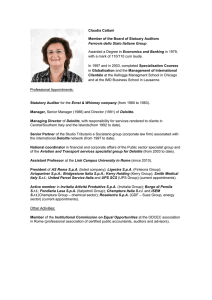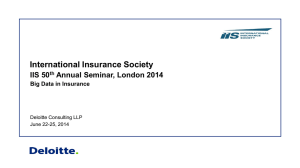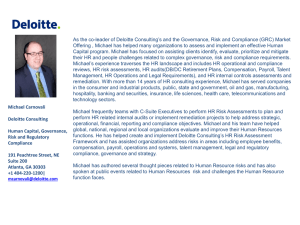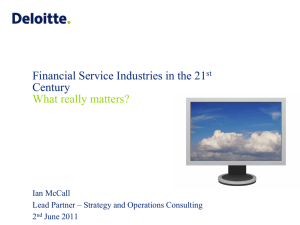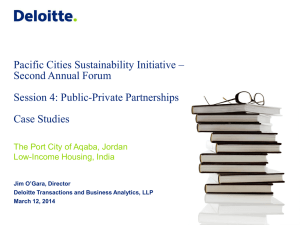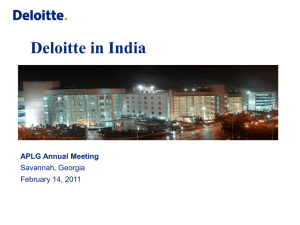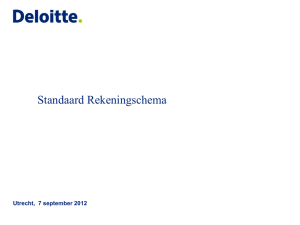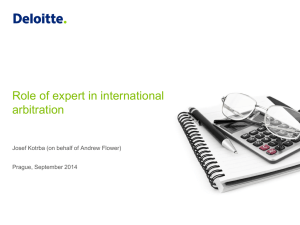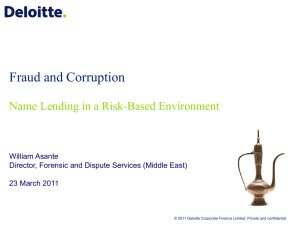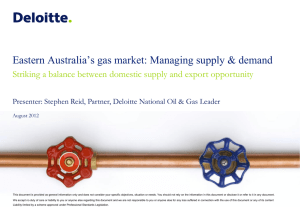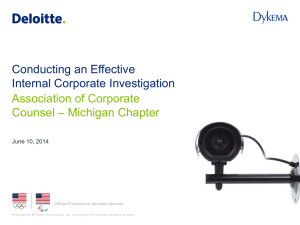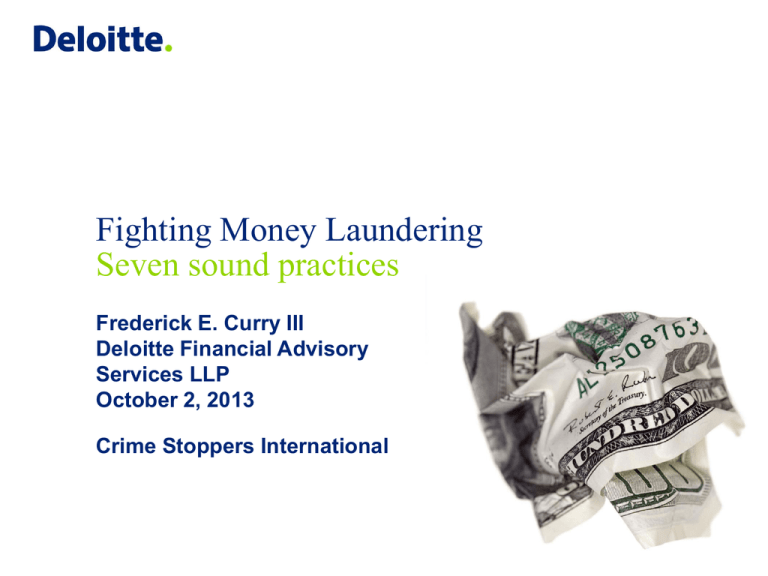
Fighting Money Laundering
Seven sound practices
Frederick E. Curry III
Deloitte Financial Advisory
Services LLP
October 2, 2013
Crime Stoppers International
Seven sound practices
1. Understand the quantity of money laundering risk at your organization
2. Confirm that policies, procedures, and controls address all products
and services that you offer
3. “Know Your Customer”
4. Commit sufficient resources to AML compliance
5. Customize employee training to address money laundering risks
6. File required regulatory reports
7. Test your compliance program regularly
1
Copyright © 2013 Deloitte Development LLC. All rights reserved.
Understand your money laundering risk
• The Board and senior management should know the quantity of money
laundering risk within your organization
• The U.S. Federal Sentencing Guidelines establish that risk assessments
are a foundational element of a compliance program
• Products, services, customers, delivery channels, and geographies
served should have a risk classification
• Relationships posing higher risks should be reviewed more closely at
the inception of the relationship and frequently throughout the term of
their relationship
• Key business stakeholders should be involved in the risk assessment
process
2
Copyright © 2013 Deloitte Development LLC. All rights reserved.
Risk assessment
• Institutions should identify, measure and consider four main risk measures
• Based on the extent and the combination of the given risk measures, the overall risk of a
customer can be quantified and differentiated through calibrated scales from Low to High
EXAMPLES OF RISK MEASURES
• Industry / Occupation
Customers
Products & Services
RISK
• Customer Geographic Location
• Length of Relationship
• Politically Exposed Person
• Typical Daily/Monthly Volume
• International Wires
• Internet Banking
• Large Cash/Large Dollar transactions
• Private Banking
• Int’l Correspondent Banking
• Face -to-Face Banking
Channels
• Internet Banking
• Agents
• OFAC
Geographies
• Areas of Primary ML Concern
• FATF Non-Cooperative Countries
• Areas identified in the annual
International Narcotics Control
Strategy Report
3
Copyright © 2013 Deloitte Development LLC. All rights reserved.
Risk assessment matrix
Inherent money laundering risk is assessed across four main risk areas.
Multiple risk factors are evaluated within each to determine the overall inherent
money laundering risk.
Risk Factor
Medium
High
Stable, known
customer base
Customer base
increasing due to
branching, merger, or
acquisition
A large and growing
customer base in a
wide and diverse
geographic area
Product / Account Type
Inherent Risk
Limited or no private
banking, trust or
asset management
accounts
Limited domestic
private banking, trust
or asset management
services
Significant domestic
and international
private banking, trust
or asset management
services
Transactional Inherent
Risk
Limited number of
funds transfers, third
party transactions,
and foreign fund
transfers
Moderate number of
funds transfers,
limited international
funds transfers with
typically lower risk
countries
Large number of funds
transfers incl.
noncustomers, PUPID
transactions and high
risk jurisdictions
Geography Inherent
Risk
No transactions with
high risk jurisdictions
Limited transactions
with high risk
jurisdictions
Significant volume of
transactions with high
risk jurisdictions
Customer Base
Inherent Risk
4
Low
Copyright © 2013 Deloitte Development LLC. All rights reserved.
Residual risk illustration
Final Inherent Risk Assessment
Final AML
Controls
Assessment
5
High
Medium
Low
Weak
High
Medium
Low
Moderate
High
Medium
Low
Strong
Medium
Low
Low
Copyright © 2013 Deloitte Development LLC. All rights reserved.
Establish detailed policies, procedures,
and controls
• Policies and procedures should be written, up to date and reviewed and
approved by Board of Directors or other authority
• Policies and procedures should cover all products and services
• Policies and procedures should be commensurate with levels of
compliance risks
• Policies and procedures should be implemented
• Policies and procedures must be effective!
6
Copyright © 2013 Deloitte Development LLC. All rights reserved.
Know Your Customer (“KYC”)
• KYC is the basic tenet of an effective AML compliance program
• KYC procedures help protect the institutions good name
• KYC is an essential part of sound risk management
• KYC procedures should articulate customer acceptance standards
• KYC provides the basis for identifying unusual or suspicious activity
7
Copyright © 2013 Deloitte Development LLC. All rights reserved.
Commit sufficient resources to compliance
• Senior management is responsible
for establishing an effective
compliance function
• The compliance executive should
be a member of senior management
• The board and senior management
is responsible for ensuring the
compliance function has the
resources to carry out its
responsibility effectively
• The compliance function should
establish an annual compliance plan
8
Copyright © 2013 Deloitte Development LLC. All rights reserved.
Customize employee training
• Education is essential in managing compliance
risks
• Training should be based on a formal training
needs assessment
• Training should be tailored to the institution’s
risk profile
• Leading practice is to train all employees at
least annually
• The board and senior management should also
receive compliance training
9
Copyright © 2013 Deloitte Development LLC. All rights reserved.
File required regulatory reports
• Reports establish a paper trail for criminal investigations
• Regulatory reporting has been highly useful in warding off criminal
prosecutions
• Regulatory reports must be accurate and filed timely
10
Copyright © 2013 Deloitte Development LLC. All rights reserved.
Test your compliance program regularly
• It is important to independently
assess the effectiveness of the
compliance program
• Leading practice is to test the
program annually
• The scope of testing should include
all products and services
• A written report summarizing the
findings should be provided to senior
management and the board
• Compliance deficiencies should be
logged and tracked to resolution
11
Copyright © 2013 Deloitte Development LLC. All rights reserved.
Most common compliance weaknesses
• Insufficient resources dedicated to compliance
• Inadequate KYC procedures
• Employees have not received relevant compliance training
• Unqualified compliance staff
• Failure to identify and periodically monitor high risk accounts or activity
• Lack of automated transaction monitoring procedures
• Poor record keeping
• Failure to file timely and accurate required regulatory reports
12
Copyright © 2013 Deloitte Development LLC. All rights reserved.
Deloitte Financial Advisory Services LLP
Frederick E. Curry III
Principal
Deloitte Financial Advisory Services LLP
555 12th Street, Suite 500
Washington, DC 20004-1207
+1 202 378-5171
fcurry@deloitte.com
This publication contains general information only and Deloitte Financial Advisory Services LLP is not, by means of this publication, rendering
accounting, business, financial, investment, legal, tax, or other professional advice or services. This publication is not a substitute for such professional
advice or services, nor should it be used as a basis for any decision or action that may affect your business. Before making any decision or taking any
action that may affect your business, you should consult a qualified professional advisor.
Deloitte Financial Advisory Services LLP shall not be responsible for any loss sustained by any person who relies on this publication.
13
Copyright © 2013 Deloitte Development LLC. All rights reserved.
About Deloitte
Deloitte refers to one or more of Deloitte Touche Tohmatsu Limited, a UK private company limited by guarantee, and its
network of member firms, each of which is a legally separate and independent entity. Please see www.deloitte.com/about for
a detailed description of the legal structure of Deloitte Touche Tohmatsu Limited and its member firms. Please see
www.deloitte.com/us/about for a detailed description of the legal structure of Deloitte LLP and its subsidiaries. Certain
services may not be available to attest clients under the rules and regulations of public accounting.
Copyright © 2011 Deloitte Development LLC. All rights reserved.
Member of Deloitte Touche Tohmatsu Limited

